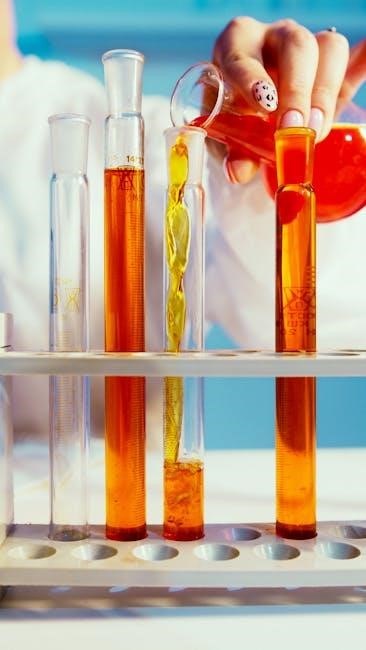pglo transformation lab answers pdf

The pGlo transformation lab introduces students to genetic engineering, using
- Escherichia coli
bacteria to explore gene expression and transformation, with a focus on molecular biology techniques and laboratory protocols.
Overview of the Lab
The pGlo transformation lab is designed to teach students about the principles of genetic engineering and molecular biology. The lab involves the use of Escherichia coli bacteria and a plasmid containing the green fluorescent protein gene. Students learn about the process of transformation, where bacteria take up free DNA molecules from their surroundings. The lab also covers the use of antibiotics, such as ampicillin, to select for bacteria that have undergone transformation. Throughout the lab, students conduct experiments and collect data to analyze the results of the transformation process. The lab is typically conducted in a controlled environment, such as a laboratory, and requires the use of specialized equipment and materials. By completing the pGlo transformation lab, students gain hands-on experience with molecular biology techniques and a deeper understanding of genetic engineering principles. The lab is often used in educational settings to introduce students to these concepts.
Principles of Bacterial Transformation
Transformation occurs when bacteria take up free DNA molecules from their environment through a process involving cell membrane permeability changes using calcium chloride solutions effectively.
Definition of Bacterial Transformation
Bacterial transformation is a process by which bacteria take up free DNA molecules from their environment, allowing them to acquire new genetic traits. This process involves the uptake of DNA fragments, which are then incorporated into the bacterial genome. The definition of bacterial transformation is closely related to the concept of horizontal gene transfer, where genetic material is exchanged between organisms other than by vertical inheritance. According to various sources, bacterial transformation is a key mechanism by which bacteria can acquire antibiotic resistance, virulence factors, and other traits that enhance their survival and fitness. The process of bacterial transformation is complex and involves several stages, including the binding of DNA to the cell surface, the uptake of DNA into the cell, and the integration of the DNA into the genome. Understanding the definition of bacterial transformation is essential for appreciating its significance in molecular biology and genetics.

pGlo Plasmid DNA
pGlo plasmid DNA contains genes for ampicillin resistance and green fluorescent protein.
Structure and Function of pGlo Plasmid
The pGlo plasmid is a circular DNA molecule that contains several genes, including the gene for green fluorescent protein and the gene for ampicillin resistance. The plasmid has a specific structure, with the genes arranged in a particular order, and it functions by allowing the host cell to express the genes it contains. The green fluorescent protein gene allows the cell to produce a fluorescent protein, which can be detected under ultraviolet light, while the ampicillin resistance gene allows the cell to grow in the presence of ampicillin. The pGlo plasmid is commonly used in molecular biology experiments, including the pGlo transformation lab, to introduce new genes into host cells and study gene expression. The plasmid’s structure and function make it a useful tool for these types of experiments, and it has been widely used in research and education. Additionally, the pGlo plasmid has been used to study the mechanisms of gene expression and regulation. Overall, the pGlo plasmid is an important tool in molecular biology research.

Transformation Procedure
Scientists use a
- step-by-step
process to transform bacteria with the pGlo plasmid, involving preparation and incubation of cells.
Steps Involved in the Transformation Procedure
The transformation procedure involves several key steps, including preparation of the bacterial cells, addition of the pGlo plasmid, and incubation of the cells to allow for gene expression.
Scientists use a specific protocol to ensure successful transformation, including the use of calcium chloride to increase cell membrane permeability and the addition of a selection agent, such as ampicillin, to identify transformed cells.
The steps involved in the transformation procedure are critical to the success of the experiment, and careful attention to detail is necessary to obtain accurate results and to ensure the safety of the laboratory personnel.
By following the established protocol and using the appropriate materials and equipment, scientists can successfully transform bacteria with the pGlo plasmid and study the resulting gene expression.
This procedure has numerous applications in fields such as genetic engineering and biotechnology.

Analysis of Transformation Results
Results are analyzed using agar plates and a fluorescence test to determine transformation success and gene expression levels in the bacteria cells accurately.
Expected Results of the Transformation Experiment
The expected results of the transformation experiment include the growth of transformed bacteria on agar plates containing ampicillin, with the bacteria exhibiting green fluorescence under UV light.
The control plates without ampicillin should show a lawn of bacterial growth, while the plates with ampicillin should only show growth of bacteria that have taken up the pGlo plasmid.
The fluorescence test should confirm the presence of the green fluorescent protein in the transformed bacteria, indicating successful transformation and gene expression.
The results should be consistent with the principles of bacterial transformation and gene expression, and should provide a clear understanding of the process.
The experiment should demonstrate the ability of bacteria to take up and express foreign DNA, and should provide a foundation for further study of genetic engineering and molecular biology techniques.
The expected results should be supported by data and observations from the experiment, and should be presented in a clear and concise manner.
and Future Directions
Lab conclusions and future directions involve analyzing results and planning new experiments to further understand genetic engineering concepts and techniques in molecular biology studies and applications everyday.
Implications of the Transformation Experiment
The implications of the transformation experiment are significant, as they demonstrate the ability to introduce foreign DNA into bacterial cells, allowing for the expression of new traits. This has major implications for fields such as genetic engineering and biotechnology. The experiment shows that bacterial cells can take up and express plasmid DNA, which can be used to produce desired proteins or other molecules. The ability to transform bacteria with plasmid DNA has many practical applications, including the production of vaccines, hormones, and other therapeutic agents. Additionally, the experiment highlights the importance of understanding the mechanisms of bacterial transformation and the role of plasmids in genetic engineering. Overall, the implications of the transformation experiment are far-reaching and have the potential to impact a wide range of fields, from medicine to agriculture. The experiment provides a foundation for further research and development in genetic engineering and biotechnology.

Lab Report Questions and Answers
Students answer lab report questions to demonstrate understanding of the pGlo transformation lab experiment and its scientific principles and applications in a clear and concise manner always.
Write-Up of the Transformation Lab
The write-up of the transformation lab requires students to document their experiment, including the materials used, procedures followed, and results obtained. This involves describing the transformation process, including the use of the pGlo plasmid and the effects of ampicillin on the bacteria. Students must also analyze their results, discussing the implications of their findings and any potential sources of error. The write-up should be clear and concise, with proper use of scientific terminology and formatting. By completing the write-up, students demonstrate their understanding of the transformation lab and their ability to communicate scientific information effectively. The write-up is typically submitted as part of the lab report, along with any supporting data or graphs. Overall, the write-up is an essential component of the transformation lab, allowing students to showcase their knowledge and skills in a comprehensive and well-organized manner.




